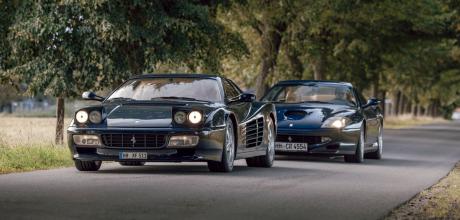1992 Ferrari 512 TR vs. 1996 Ferrari 550 Maranello
They are two Ferraris at the turn of the last millennium, two grand tourers for an audience that can't do without twelve cylinders. And yet, they are so different! The Testarossa successor, the 512 TR, is a result of racing evolution, while the successor 550 Maranello follows in the lineage of the elegant 365 GTB/4 Daytona.
HOUR OF FERRARI 512 TR + 550 MARANELLO
In terms of production years, there are only a few months between this 512 TR and this 550 Maranello. However, conceptually, dynamically, and atmospherically, they are worlds apart.
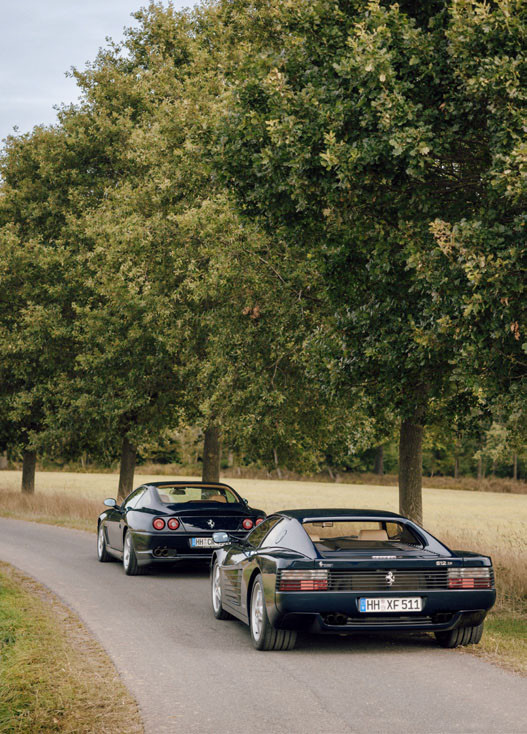
The 1990s feel closer than they actually are, and with the cars, the modern types of this decade, it's like with good old friends: Suddenly, we realize that they are not as young as we always imagined them in our minds' eye. And suddenly, the insider tips from yesterday are on the verge of becoming classic cars.
The 512 TR has already come a long way: The first units of the series introduced in 1992 have already celebrated their 30th anniversary. For the last of its kind, painted in Blu Scuro and registered in January 1996, when only the F512 M and the successor 550 Maranello were available for purchase, it is still a distant milestone. But we'll come back to this special case later.
The late Testarossa models, the 512 TR and F512 M, were long overlooked because the status of the '80s icon obstructed the view of their advancements. The sensation of the new original model and the shadow of Pininfarina design, often copied and passed down to popular tuning zones, was simply too overwhelming.
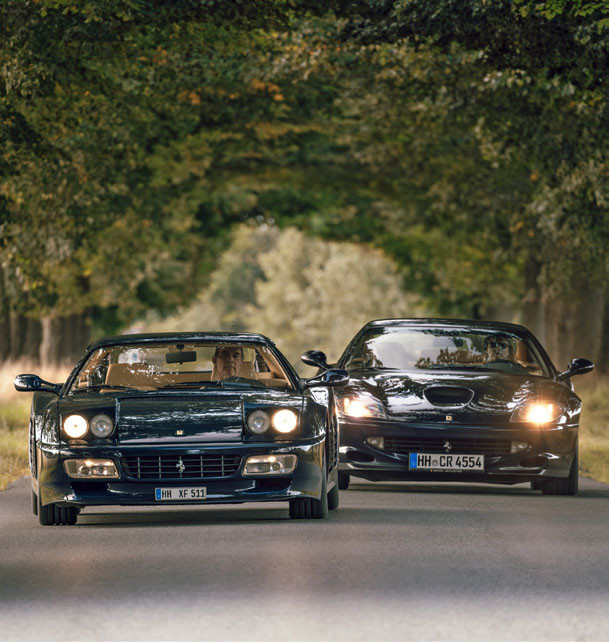
In total, the mid-engine series with its three development stages, Testarossa, 512 TR, and F512 M, produced around 10,000 vehicles between 1984 and 1996. However, to consider the two 512 variants merely as facelifts of the original model would not do them justice.
EVOLUTION IS A BETTER DESCRIPTION
The distinctly flat and extra-wide designer line of the Testarossa from 1984 is only slightly smoothed out in the 512 TR. Pop-up headlights are a must, and the side profile with the looong, horizontal air intakes that extend from the doors to the rear fenders has remained. At the rear, the louvers, which are unusually square-shaped and have a satin finish, run all around the car and across the large hood. Meanwhile, the front of the 512 TR adopts the design of its little brother, the 348, with its two large auxiliary headlights in the bumper. This iconic overall design arrived in the '90s in a streamlined and dynamic manner—modernized yet unmistakable.
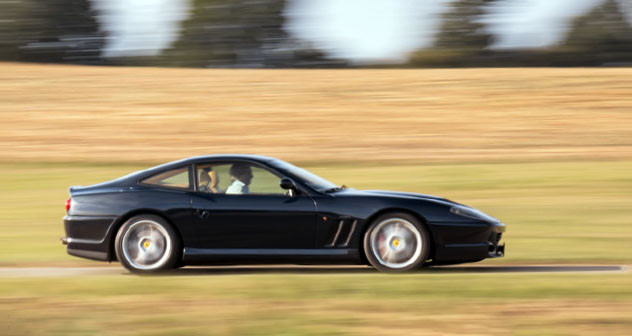
The same goes for the five-liter V12 engine, nestled in the middle of the car beneath voluminous air collectors bearing the Ferrari and Testarossa emblems. The TR engine, type F113 D, is an evolution of the Testarossa engine (F113 A). Lighter pistons, a modified crankshaft, and an increased compression ratio from 9.3:1 to 10:1 were among the ingredients that provided the four-valve aluminum alloy engine, with its valve covers coated in red shrink lacquer, with a power increase of 38 hp and a torque increase to 491 Nm at 5500 rpm, all while maintaining the same displacement.
With that, the engine broke the 400 horsepower barrier: the longitudinally-mounted 180° V12 delivers 428 horsepower at 6750 rpm. It looks stunning, and the higher the twelve-cylinder revs, the louder and more mechanical the sound from the rear becomes. Owner Philip Moffat attests to the 512 TR having «more oomph,» a more precise gearbox, and above all, much better brakes – a result of the increased wheel/tire combinations from 16 to 18 inches – compared to the original Testarossa model. The 512 TR is a few millimeters shorter and taller, but the engine sits two and a half centimeters lower in the lattice frame.
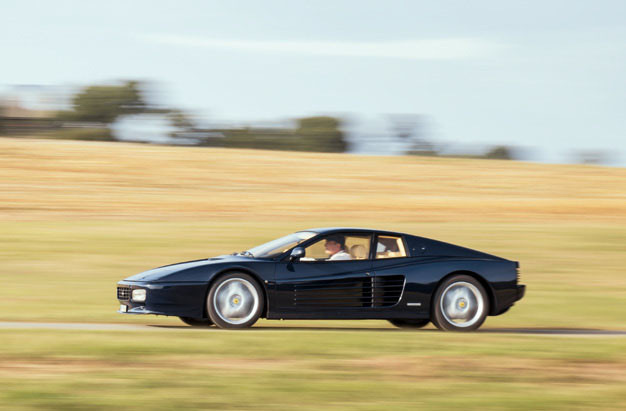
The testers from auto, motor + sport compared the V12 to a mechanical masterpiece and praised its excellent elasticity, a broad usable rev range, turbine-like performance, and an inspiring sound. «The 512 TR is a car that looks faster even when standing still than others can drive.» Even the ride comfort is decent, the handling more predictable than its unrefined predecessor, and it comes with air conditioning as standard, was noted. Criticisms included the intense load-change reactions and the uncomfortable seating position with the wheel arch protruding into the footwell. But there's always something, isn't there?
PRIDE OF A COLLECTOR
With only 95,000 km on the odometer and the fine patina of a beloved and driven car, Philip Moffat found his 512 TR – the unusual story unfolded only afterwards. «The first registration from Switzerland dates back to January 10, 1996, making it the last registered 512 TR,» says Moffat. Why it took so long, no one can say, but the 512 TR's history is documented by Ferrari. «And it's the only one in Blu Scuro. Probably 95 percent are red, there are also a few yellow and white 512 TRs. But there's only one blue!»
Inside, the car features Crema leather and easy-to-maintain black carpets – it sounds tailor-made. The 512 TR benefits from updates and new materials, with a clean-looking cockpit. The small instruments labeled in orange have remained, but the plastics and craftsmanship feel higher quality, even though the slender turn signal stalks come from Lancia. Inside, the 80s are truly over. The unusual and deliberately understated colour combination shifts the character of the 512 TR from a dream sports car to a sophisticated grand tourer. When the dark rear grille no longer contrasts the car's impressive width, the 512 TR appears less aggressive. Colour can indeed make a difference!
BACK TO THE FUTURE
Less expressive in design, not as radically inspired by racing, but much more sophisticated – the 550 Maranello, successor to the Testarossa series and inheritor of the great front-engined berlinettas, does (almost) everything differently. Based on the larger 456 GT, the development of the two-seater took only 30 months. And as promised by Ferrari CEO Luca di Montezemolo, the new flagship GT, «the car for the 21st century,» demanded less compromise from its occupants. More comfort and some luxury were the stated goals. There was also more luggage space, but with a volume of 185 liters, not too much, as the differential and gearbox had to fit in the rear due to the transaxle layout.
Like the 512 TR, the 550 Maranello had only two seats, but its engine was once again placed at the front. «The horses must pull the cart and not push it,» Enzo Ferrari was already sure.
The V12 engine with a displacement of 5.5 liters was both a new generation of engines and a further development of the twelve-cylinder engine from the 456 GT. In 1992, the 2+2 model debuted with the first V12 engine for a road car, featuring a cylinder bank angle of 65 degrees.
The engine block, cylinder heads, oil pan, timing cover, and valve covers were made of lightweight alloy. The unusual cylinder bank angle originated from the Formula 1 cars of the Type 640, which Gerhard Berger and Nigel Mansell drove in the 1989 season. Michael Schumacher, the current factory driver, confirmed his involvement in the engine tuning during the presentation of the 550 Maranello.
Equipped with four overhead camshafts and four valves per cylinder, the V12 engine (Type F133) produced 485 horsepower at 7000 rpm and a torque of 569 Nm at 5000 rpm. This was enough to lap the three-kilometer-long Ferrari test track at Fiorano three seconds faster than its predecessor and reach a top speed of 300 km/h at the end of the straight.
Compared to the 512 TR, the 550 Maranello not only had a higher top speed of 320 km/h but also featured contemporary features such as a six-speed transmission, ZF power steering, ABS, airbags, adjustable traction control, and optimized aerodynamics with an enclosed underbody. Remarkably, it offered these advancements while maintaining a nearly identical price of 324,700 German Marks, providing substantial added value.
The backbone of the 550 Maranello's drivetrain and chassis was a steel tube frame onto which the lightweight alloy body was welded using a special alloy. Ferrari's new Gran Turismo was not just a new car but a true representation of a new era in automotive design.
Between the Blu Scuro 512 TR and the Blu Pozzi 550 Maranello, it may feel like more than 20 years have passed, but in reality, it's only been two. The Austrian first owner combined an elegant full leather interior in beige, complete with diamond-stitched pattern from the dashboard to the rear shelf, with the dynamic Fiorano Handling Package, easily recognizable by the red-painted Brembo brake calipers – luxury combined with performance.
Inside the cockpit, with its seven Jaeger round instruments, electrically adjustable and well-cushioned seats, and length- and tilt-adjustable steering column, the pursuit of comfort and refinement is palpable throughout. The high central tunnel divides the interior, housing the triple-supported driveshaft connecting the engine and transmission at the rear axle, and it offers two halves. A subtle lowering and thicker stabilizers were part of the Fiorano Sport Package.
The design and rear view, with its round taillights, carry much of the iconic styling of the 1970s 356 GTB/4. Owner Chris Ribbe, who embarked on a decade-long search for the ideal 550 Maranello, describes it as «aesthetically valuable, a classic beauty.» Back then, certain Ferraris from the 1990s were still considered hidden gems. It feels like a long time ago.
The interior design, featuring fine two-tone leather, remains a specialty of the Ferrari brand to this day. In the 550 Maranello, there are still plenty of round instruments dominating the cockpit.
For purists, the open gearshift layout, now with four gates and a reverse gear relocated for safety, remains a pleasure. The 550 Maranello was a genuine Gran Turismo, thanks to its reasonable trunk space and additional luggage area when the rear seatback is folded.
In terms of design and rear view, there is a lot of the iconic 356 GTB/4 from the 1970s. «Aesthetically valuable, a classic beauty,» as owner Chris Ribbe describes it, who began his search for the perfect 550 Maranello ten years ago. Back then, some Ferraris from the 1990s were still considered hidden gems. It's been a long time.
The interior design, with fine two-tone leather, remains a specialty of Ferrari. The 550 Maranello still featured plenty of round instruments.
For purists, it's still a delight: the open gearshift gate, now with four gears and a reverse gear moved out of harm's way. The 550 Maranello was a true grand tourer, thanks to a practical trunk and additional luggage space when the rear seatback is folded down (opposite page).
With half a liter more displacement and over sixty horsepower stronger, the V12 engine of the 550 Maranello resided under the front hood. Its 65-degree cylinder angle allowed it to fit snugly between the wheel arches.
The conventionally designed 550 Maranello proved to be more practical in all aspects compared to its predecessor, the mid-engine «Flunder» (a reference to the Testarossa). Ferrari enthusiasts initially found it hard to believe that it was also faster and more sporty.
Open gearshift gate and gauges turned towards the driver: the 512 TR was a machine of the old school. It could accommodate some luggage under the front hood.
On the opposite page: the V12 nestled flat between the rear wheels of the 512 TR. The engine concept of the Testarossa series originated from Formula 1.
With the 512 TR, the era of pop-up headlights at Ferrari was slowly coming to an end. Its successor, the F512 M, already had fixed glass double headlights.
Classic meets modern: Indeed, the 512 TR, with its more progressive design, was the predecessor of the 550 Maranello.
TECHNICAL DATA Ferrari 512 TR
- Production Years: 1992-1994
- Production Quantity: 2261
ENGINE
- Type: V12, longitudinally mounted in front of the rear axle
- Cylinder Angle: 180 degrees
- Valve Control: Two overhead camshafts, driven by timing belts
- Displacement: 4943 cm3
- Bore x Stroke: 82.0 x 78.0 mm
- Max Power: 315 kW (428 hp) at 6750 rpm
- Fuel System: Electronic injection Bosch Motronic
- Drive: Five-speed gearbox, rear-wheel drive
BODY
- Structure: Tubular frame, lightweight aluminum body
- Curb Weight: 1644 kg
- Maximum Permissible Weight: 1840 kg
CHASSIS
- Front Suspension: Independent suspension with double wishbones, coil springs and telescopic shock absorbers, stabilizer bar
- Rear Suspension: Independent suspension with double wishbones, two coil springs and two telescopic shock absorbers, stabilizer bar
- Brakes: Four-piston calipers, ventilated discs front and rear
- Wheels/Tires: 8J x 18 with 235/40 ZR 18 front, 10.5J x 18 with 295/35 ZR 18 rear
DATA & MEASUREMENTS
- Wheelbase: 2550 mm
- Track: 1532 mm front, 1644 mm rear
- Acceleration: 0-100 km/h: 4.8 s
- Top Speed: 314 km/h
- Fuel Consumption: 20.5 l/100 km
- Price: 320,000 German Marks
TECHNICAL SPECIFICATIONS Ferrari 550 Maranello
- Production Period: 1996-2001
- Production Quantity: 3600 units
ENGINE
- Type: V12, longitudinally mounted at the front
- Cylinder Angle: 65 degrees
- Valve Control: Twin overhead camshafts, driven by timing belt
- Displacement: 5474 cc
- Bore x Stroke: 88.0 x 75.0 mm
- Max Power: 356 kW (485 hp) at 7000 rpm
- Fuel System: Bosch electronic fuel injection, Motronic
- Transmission: Six-speed manual, rear-wheel drive
BODY
- Structure: Tubular frame, lightweight aluminum body
- Curb Weight: 1690 kg
- Gross Vehicle Weight: 1950 kg
CHASSIS
- Front Suspension: Independent suspension with double wishbones, coaxial springs, and gas shock absorbers, stabilizer bar
- Rear Suspension: Independent suspension with trapezoidal and triangular wishbones, coaxial springs, and gas shock absorbers, stabilizer bar
- Brakes: Four-piston calipers, ventilated disc brakes front and rear
- Wheels/Tires: 8.5J x 18 with 255/40 ZR 18 tires in the front, 10.5J x 18 with 295/35 ZR 18 tires in the rear
DATA & MEASUREMENTS
- Wheelbase: 2500 mm
- Track Width: 1632 mm front, 1586 mm rear
- Acceleration 0-100 km/h: 4.4 s
- Top Speed: 320 km/h
- Fuel Consumption: 20.5 liters per 100 km
- Price: 324,700 Deutsche Mark


